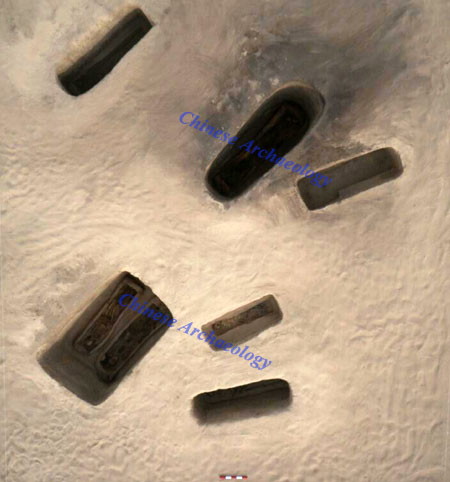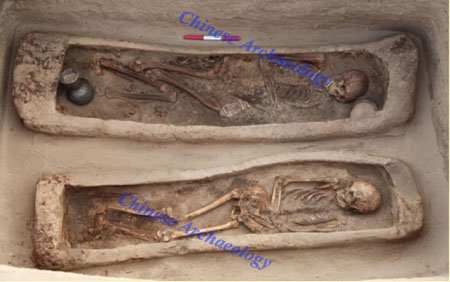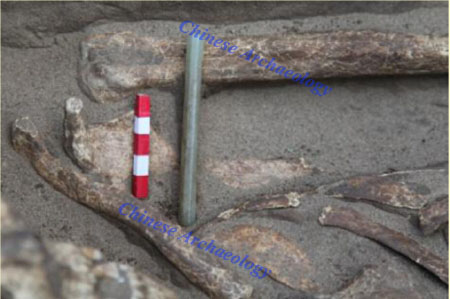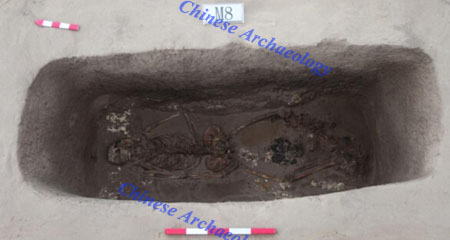Single-log Coffins from 8-10 Centuries AD Found in Gang’ga Cemetery, Inner Mongolia
From:Chinese Archaeology NetWriter:Date:2015-01-12
From July to October, 2014, Gang’ga cemetery has been systematically drilled and formally excavated by Hulunbuir jointly archaeological team consisting of Institute of Archaeology, Chinese Academy of Social Sciences, Inner Mongolia Autonomous Region Institute of Cultural Relics and Archaeology, School of Archaeology and Museology, Peking University as well as Hulunbuir National Museum.

burials distributing in the east part of the excavation area

burial M18 of the east part

bronze belts from burial M22 of the east part
Gang’ga cemetery is located at Huhenuoer Town, Chen Barag Banner, Hulunbuir City, Inner Mongolia Autonomous Region. The excavated area covers 680 square meters. 16 tombs have been cleared and all are rectangular vertical shaft tombs with a flat bottom. 15 of them have wooden funeral furniture. Among them, 9 have single-log coffins and the rest have wooden coffins. The single-log coffins are made of whole sections of pines with an elongated groove hewed out of the top end where the deceased and burial gifts wrapped in barks and furs are placed. Wooden coffins are all rectangular in plane, consisting of two long boards in both sides and two short boards in both ends. Some of them paved birch barks in the bottom, others have nothing at all. Most of the deceased are lying in extended supine position or flexed on one side, and headed towards the north, northwest or northeast. Most of the tombs are single burial with one exception, that is, M18. M18 is the first discovery of male and female joint single-log coffin burial in Hulunbuir city. The tomb owners are a grown female and ajuvenile male. What’s more, M20, as the largest tomb found in this season with a well-preserved, 2.23 m-long single-log coffin, provides new material for the form, structure and usage of single-log coffins.

burial M11 of the west part

jade ornament found in burial M11
Various kinds of burial gifts are discovered, including daily-used utensils, ornaments, production tools, weapons as well as harnesses and etc.. The daily-use vessels conclude pottery jars, pottery pots and birch bark made jars and so on. Ornaments have jade bars, red agate beads, glass beads, copper belts as well as copper and silver earrings and so forth. Tools and weapons range from birch bark bows, quivers, iron arrowheads, iron knives and so on. Moreover, there are stirrups, horse-bits and etc..

burial M7 of the west part

burial M8 of the west part
There are 86 tombs being discovered by drilling. And 22 have already been unearthed. The excavation of Gang’ga cemetery is of important academic values for the origins of Mongolia nationality in terms of the following aspects.
1. As the largest ancient cemetery so far found in Hulunbuir prairie, Gang’ga cemetery with the single-log coffins and rich funeral gifts, dating back to 8-10 centuries AD, is the most important archaeological discovery in Hulunbuir prairie.
2. Gang’ga tombs are quite different from the tombs of Xianbei and Liao dynasty found in Hulunbuir prairie so far in terms of funeral furniture, burial customs and characteristics of burial gifts and so on. However, they bear certain similarities with Xie’ertala and Xiwuzhu’er tombs. With the consideration of documents, Gang’ga cemetery is preliminarily predicted to be the remains of Shiwei people in 8-10 centuries AD and gives latest archaeological clues for the origins of Mongolia nationality.
3. According to the results of physical anthropological research, the ancient people of Gang’ga cemetery have relatively round, low and wide craniums which are very close to those of the Central Asia type of northern Mongoloid lived in Mongolia and Inner Mongolia. The discovery of Gang’ga cemetery lays significant foundation for academic research of Hulunbuir prairie as the origin place of Mongolia nationality.
4. The archaeological excavation of Gang’ga cemetery has been carried out in the idea and methodology of experimental archaeology that each tomb is put into a large container as a whole part and all of the tombs are taken back to the lab so that experimental researches and exhibitions in the museum can be conducted later on. (Translator: Ma Huanhuan)

